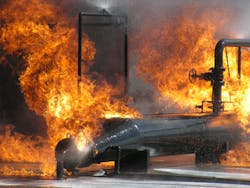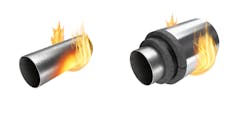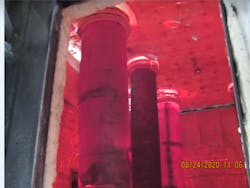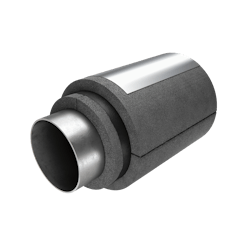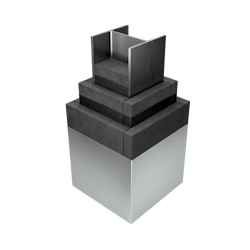Specifying passive fire protection: 3 testing takeaways
Safety will always be priority one, and at facilities managing, storing or processing hydrocarbon products, defending against the risk of fire is an area of constant focus. Oil and gas refineries, as well as petrochemical facilities, are good examples of structures that face this sustained exposure by virtue of the materials and processes they house. Although safety has always been a high priority in these facilities, it is gaining even more attention as sites are asked to run continuously and locations may be closer to populated areas. Decisions made during the facility design and maintenance/retrofitting can help improve overall site safety and aid in safeguarding people and equipment.
Risk factors for fire
Storing and handling flammable materials carries an inherent risk of onsite fire occurring. Elements that increase the risk of fire and combustion-related accidents include leaks, spills or pipe or tank ruptures. Such accidents can discharge flammable material or hydrocarbons which can be ignited upon contact with a spark. In the industrial environment, sparks can be generated many ways including through routine maintenance, static buildup or weather events.
An added challenge of managing fires at hydrocarbons processing or storage facilities is the temperature of the fire. Hydrocarbon-fueled fires can rapidly climb in temperature, reaching 2,000°F or more within minutes of the fire starting, which is a faster escalation than would be anticipated in an event like a structure fire.
To protect against temperature rise of protected substrates (piping, equipment and structural elements) and to maintain structural integrity, industrial facilities may install insulation systems, intumescent coatings or hybrid systems (insulation systems paired with intumescent coatings). Insulation systems work by resisting the flow of heat to the substrate beneath. Hybrid systems combine both insulation and intumescent coatings to protect the substrate. In these systems, the intumescent coating is applied to the outside of the insulation. When subjected to heat, the intumescent coating undergoes a chemical reaction, expanding and combusting internally, to form an expanded insulating layer. It is important to note that the insulation system or coating should be replaced if subjected to a fire event.
Elements of testing
Based on the temperatures involved and the types of fires that could ignite in an industrial setting where hydrocarbon fuels are used, two styles of testing methods are commonly used to assess how long passive fire protection systems will provide protection to insulated materials. As the name implies, passive fire protection systems remain in place, helping thwart the spread of fire or smoke, and restricting the fire to its area of origin. Passive systems aim to hinder a fire from spreading throughout a facility, providing more time for occupant evacuation and curbing the path of destruction.
Two tests include UL 1709 — Standards for rapid rise fire tests of protection material for structural steel - and the “jet fire” test or ISO 22899 — Determination of the resistance to jet fires of passive fire protection materials — part 1 — general requirements.1,2
The test method used for UL 1709 involves installing the insulation on an item to be protected — like a structural steel piece — and placing everything in a furnace running at 2,000°F. The insulating material is considered to have “failed” when the material being protected reaches 1,000°F. The amount of time before failure occurs dictates the time rating of the protection granted by that insulation or insulating system.
The jet fire test focuses on material response to directional or intensive and localized fire events. During the test, insulation or the insulating system is sprayed with fire emanating from a specific point — sort of in line with being sprayed by a hose of fire.
As a pioneer in life safety systems for industrial and commercial buildings, Owens Corning works with relevant bodies to test and evaluate the duration of the response delivered by multiple passive fire systems. Testing conducted in 2021, including both types of testing described above, yielded data that validates material performance, and offers insights on what to consider when specifying or installing passive fire protection systems in the industrial space. Three takeaways are shared below:
Takeaway #1: Insulation can provide thermal regulation and passive fire protection
Insulation can do double duty, providing thermal regulation and passive fire protection to equipment, structural steel elements, tanks or storage vessels and piping. Thermal insulation is typically installed to regulate operating system temperatures. When properly designed and installed, insulation also can provide up to several hours of protection for critical parts of the facility. This protection is delivered by protecting against temperatures, managing thermal flux, slowing fire spread and lengthening the amount of time it takes for piping or equipment to reach dangerous temperatures.
The most important goal when installing passive fire protection systems at facilities like oil and gas refineries or LNG and petrochemical handling sites is to improve life safety as well as overall site safety. Passive fire protection systems help maintain the integrity of piping, storage vessels and structural elements on-site — like the legs of a spherical storage tank — if a fire occurs. Passive fire protection is intended to provide time for a fire to be managed or equipment to be safety shut down. It is designed to retard fire spread and may support the ability for employees to reach safety. Testing demonstrated that insulating materials can be used to protect against the rapid rise to high temperatures resulting from a hydrocarbon-based fire. When insulation is properly specified and installed, it can provide several hours of mitigation in these conditions. Studies show that when insulation based passive fire protection systems encounter jet fire conditions, passive fire protection also can supply more than an hour of damage mitigation.
Takeaway #2: Properties of the insulation materials used in passive fire protection matter
Testing demonstrates that the properties of the insulating materials used in passive fire protection, as well as the applications — below-ambient, ambient or above-ambient temperatures — where the insulating materials are being applied influence performance. When it comes to using thermal insulation to provide passive fire protection for structural steel, equipment, piping and hydrocarbon storage tanks or spheres, both the nature of the insulation and the temperature of the materials being protected are important. Questions that must be asked about a material include:
- Is the material combustible?
- Will the material spread flame, generate smoke or absorb flammable liquids?
- How may the mass of the material, thermal conductivity and maximum operating temperatures influence its performance during a fire?
Insulating materials used in passive fire protection systems need to lightweight, non-combustible, non-absorbent, inorganic and have a high maximum operating temperature. Viewed through this lens, materials like closed-cell cellular glass insulation and mineral wool intended for use in passive fire protection systems perform well. Both cellular glass and mineral wool materials do not burn when exposed to fire and don’t generate smoke, which can obscure exit pathways or provide a hazard to employees.
Additionally, both materials are inorganic and have high maximum operating temperatures. Cellular glass insulation will not absorb flammable liquids, thereby reducing the potential for fires to occur or continue. Both insulations also have attributes that perform well across temperature ranges, ranging from cryogenic to above ambient and hot applications. Technical consultation during the design phase can help determine the appropriate insulation system for the application.
Takeaway #3: Tailoring a system’s materials to the application and environment can contribute to time for egress and provide thermal protection
The environment and the application should influence the materials used on any job. There are many situations where a single insulation material with compatible accessories can be the passive fire protection solution for an application. Other times, additional components in the insulation system can help provide optimal protection, especially when properties can deliver complimentary performance attributes.
For example, in cryogenic applications where there are acoustical considerations combining the below-ambient performance of cellular glass insulation with the renowned fire-resistance of mineral wool insulation — can extend the amount of time passive fire protection systems provide thermal protection during extreme conditions.
Other applications may suggest other combinations of insulating materials or intumescent coatings to support the overriding goal of protecting life safety. For example, combining a rigid, inorganic insulation, like cellular glass insulation, and an intumescent material into a passive fire protection system demonstrated that it could provide up to four hours of protection during jet fire testing.
Testing demonstrates not only that insulating systems can provide protection against hazardous conditions but how long it takes different systems to reach critical temperatures.
Conclusion
Passive fire protection is one method to help address the risk of fire occurring at facilities that store, manage or process hydrocarbons and flammable products. Although high-performing materials intended for use in passive fire protection systems are not inexpensive, properly designed and installed insulation systems can cost-effectively serve two roles: managing system operating temperatures and providing passive fire protection for structural steel elements, equipment, piping and storage vessels. The inclusion of passive fire protection systems helps safeguard occupants as well as equipment and piping that drive processes. Following testing intended to determine how long passive fire protection systems function under conditions of rapidly increasing temperature or focused-fire situations, three takeaways can support material decisions for passive fire protection.
First, thermal insulation can provide passive fire protection when correctly designed and installed. Second, the materials selected for use in these systems are important; and third, a system or combination of insulating materials tailored to the environment and application can extend the length of time these materials perform. Selecting insulating materials that are inorganic, non-absorbent, non-combustible materials and will not generate smoke when exposed to fire — like cellular glass insulation and mineral wool insulation — can contribute to a high-performing passive fire protection system.
References
1 – Underwriters Laboratories Standards. (2017) Standard for rapid rise fire tests of protection materials for structural steel. (UL Standard 1709, 5th edition.) https://standardscatalog.ul.com/ProductDetail.aspx?productId=UL1709
2 – International Organization for Standardization. (2021) Determination of the resistance to jet fires of passive fire protection materials – part 1: general requirements (ISO Standard No. 22899-1:2021). https://www.iso.org/standard/39750.html
